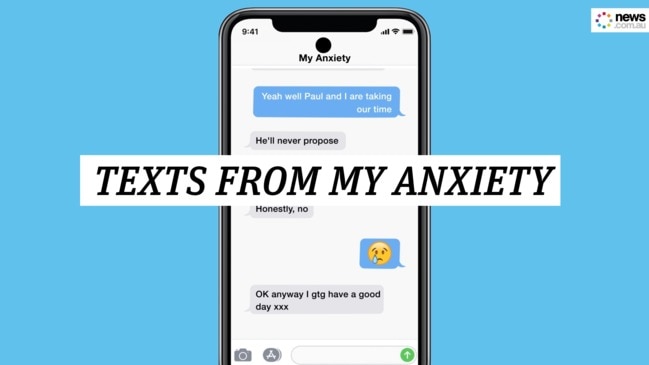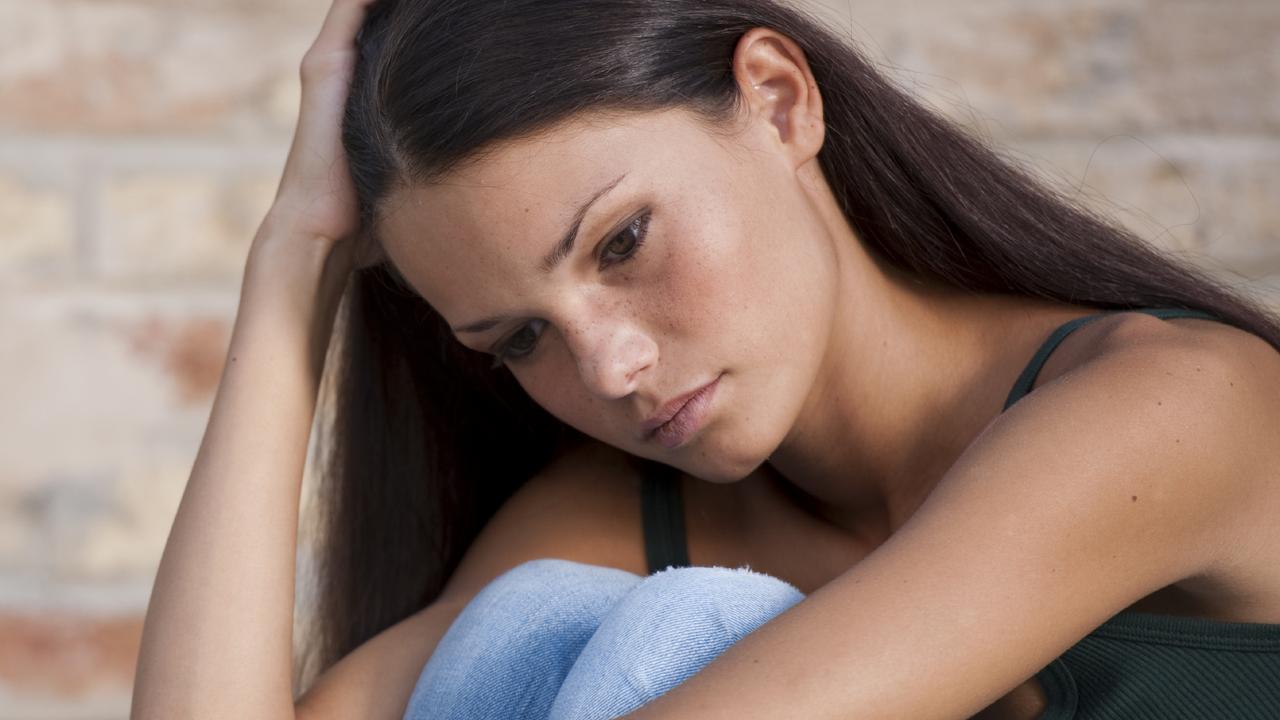The anxiety conditions affecting millions of Aussies
For a surprisingly high number of Aussies, everyday tasks such as grabbing a meal with friends can be absolutely debilitating.

Anxiety is an important and normal part of our fight-or-flight response when we perceive danger, and it can keep us safe in many situations.
It becomes problematic, however, when it sticks around for a long period of time once the dangerous or threatening situation has passed, explains Black Dog Institute clinical psychologist Aliza Werner-Seidler.
“The main difference between problematic anxiety and feeling nervous is when it interferes significantly with how we want to be doing things, or how distressing it is for the person experiencing it,” she said.
“Some anxiety before an important test, sports game or job interview can actually enhance performance — but if anxiety is stopping someone from their daily activities, then it becomes a problem.”
According to Beyond Blue, on average one in four Australians — one in three women and one in five men — will experience an anxiety condition at one stage in their life. It is the most prevalent mental health problem in Australia.
“These are really common problems,” Beyond Blue clinical adviser Grant Blashki said.
“I often say to my students, ‘Just look around your family and your friendship group, and chances are you’ll know someone who is having anxiety issues.’”
News.com.au is this month raising awareness of good mental health as part of its campaign Let’s Make Some Noise. We are highlighting the issue of anxiety and its cost to employers, the community, families and sufferers in support of Beyond Blue.
Anxiety has a wide range of subtypes, the core tenant of which is excessive fear and worry.
“The six flavours, if you like, are generalised anxiety disorder, social anxiety, panic disorder or panic attacks, obsessive-compulsive disorder, post-traumatic stress disorder, and phobias,” Dr Blashki said.

SOCIAL ANXIETY
While it’s normal to feel nervous in social situations where we might come under the attention of others, for people who suffer from social anxiety, the simplest of tasks — like going out for coffee — can become difficult.
“They get obsessed with what other people are thinking about them,” Dr Blashki said.
While the condition has “different styles” and manifests differently in each person, someone with social anxiety thinks “the people they’re with may be watching them eat or judging them”.
Social anxiety often occurs in the lead-up to or during performance situations, such as giving a speech, or situations that involve social interaction, such as having a meal with friends or making small talk.
Those who suffer from the condition fear being judged, criticised, laughed at or humiliated in front of others, and they tend to withdraw.
“They might not work, and they’re just intensely worried about what everyone thinks of them, at all times,” Dr Blashki said.
GENERALISED ANXIETY DISORDER
People with generalised anxiety disorder (GAD) feel anxious not just in specific situations, but most of the time, and these worries are intense, persistent and interfere with their normal lives.
“They worry about work, home — anything you can worry about, they overthink it and they catastrophise things,” Dr Blashki said.
“It’s exhausting for them because they’re very worried about everything.”
Every year in Australia, about 3 per cent of the population will experience GAD, and 5 per cent of Australians are affected by it at some point in their lives.
Those with GAD feel anxious on most days for a period of at least six months, with their excessive worries about family, financial, work or health problems potentially taking a toll on their work and social life.
A combination of biological, psychological or stress factors may be involved in causing the condition, and those affected may experience related disorders, most commonly depression, social phobia or other strains of anxiety.

OBSESSIVE-COMPULSIVE DISORDER
Between 2 and 3 per cent of Australians are affected by obsessive-compulsive disorder (OCD) — experiencing persistent unwanted fears and thoughts that cause anxiety — at least once in their lives.
These obsessions can make people feel the need to carry out “debilitating” rituals, known as compulsions, in order to feel less anxious.
“This is where people are washing their hands because they’re worried about germs or checking things over and over, or going back home because they don’t believe themselves that they locked the house or turned off the gas,” Dr Blashki said.
Common obsessions include:
• Fear of becoming sick
• Fear of forgetting to do things
• Fear of being contaminated
• Fear of not being able to do things in an exact or orderly way.
Common compulsions include:
• Constantly cleaning, tidying or rearranging
• Constantly checking that doors are locked or appliances turned off
• Constantly washing hands or showering
• Hoarding items, such as newspapers and books.
PANIC DISORDER
Panic disorder is the term used to describe when panic attacks are recurrent and disabling. Dr Blashki described it as “a sudden overwhelming rush of adrenaline, where your heart’s racing, and you just have to get out”.
A panic attack reaches its peak within about 10 minutes and usually lasts for up to half an hour, and a person in the midst of one may feel that they are dying, which can exacerbate the situation.
Panic disorder can also be characterised by worrying for at least a month after having a panic attack that you’ll have another, worrying about the implications of a panic attack or undergoing significant changes in your behaviour related to panic attacks.
“The classic pattern with people who suffer from panic disorder is they’ll start avoiding places where they don’t think they can get out quickly,” Dr Blashki said.
“They might find they don’t want to go on public transport or they don’t want to fly, or they might not like getting in lifts or even going to the cinemas, because they always want an exit plan.”
About 3 per cent of Australians experience panic disorder — where they have an attack at least four times a month — and about one in three will experience at least one panic attack in their life.

SPECIFIC PHOBIAS
While concern or fear of certain activities, animals, situations or objects is not uncommon, those who experience specific phobias imagine or irrationally exaggerate the “danger” they could face.
Their feelings of panic, fear or terror are out of proportion to the actual threat — and often, they’re aware their fears are exaggerated, but feel their reaction is out of their control.
About 9 per cent of Australians experience a phobia at some point in their lives and people often have more than one.
Specific phobias are generally divided up into the following categories:
• Animals or insects
• Natural environment
• Fear associated with invasive medical procedures, or with seeing blood or injury
• Fear of specific situations.
Common phobias include:
• Agoraphobia:fear of open spaces
• Acrophobia:fear of heights
• Social phobia:fear of social situations
• Claustrophobia:fear of small spaces
• Mysophobia:fear of dirt and germs.
POST-TRAUMATIC STRESS DISORDER
Post-traumatic stress disorder (PTSD) is “when people have had a traumatic event — whether that be in the military, a car accident, or even a sexual assault — and they re-experience the symptoms afterwards”, Dr Blashki explained.
About 12 per cent of Australians will experience PTSD in their lifetime, with serious accidents one of the leading causes of the condition.
“It’s often also associated with an emotional numbing, feeling disconnected from things, and it can be quite disabling,” Dr Blashki said.
Apart from the event itself, risk factors for developing PTSD include a past history of trauma, previous mental health problems, ongoing stressful life events after the trauma and an absence of support.
If you’re struggling to manage your anxiety, make an appointment to see your GP to talk through your issues and explore treatment options.




